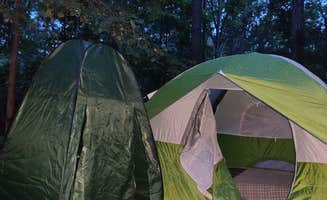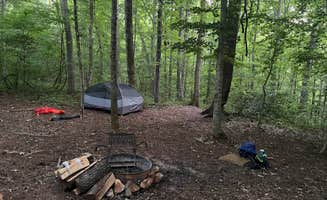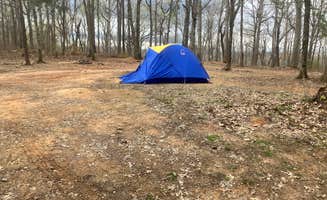Dispersed camping near Franklinville, North Carolina includes multiple free primitive sites throughout the Uwharrie National Forest. This area features elevations between 500-800 feet with mixed hardwood forests and pine stands. Many dispersed sites require 4WD or AWD vehicles to access, particularly during wet weather when forest service roads can become muddy and difficult to navigate.
What to do
Off-road adventures: The Uwharrie National Forest offers extensive OHV trails for Jeeps and off-road vehicles. A camper noted, "We took our Jeep on the OHV trails and had a blast. There are several places you can take a canoe or kayak on and the scenery on the lake was beautiful as well." Passes for overnight use can be purchased at several local stores.
Backpacking trails: The 20-mile Uwharrie Trail spans north-south through the forest and connects numerous dispersed camping areas. "The trailhead is kind of hard to follow sometimes, sections of the trail are prone to flooding and creek crossings can become difficult following heavy rains," reports one backpacker at Uwharrie National Forest.
Watercraft exploration: Paddlers can access remote camping spots by kayak or canoe along the Little River. "Me and my friends would always float our kayaks down the river to a place we called 'Bird Dog' and camp for the night," explains one regular camper. The boat ramp where Pekin Road crosses the Little River provides convenient water access.
What campers like
Secluded sites: Many campers appreciate the privacy found at Birkhead Mountain Wilderness Area Dispersed, where one visitor noted, "Very nice trails. Well maintained. Not marked the best... signs at intersections. Plenty of creeks. Hike in for dispersed camping."
Established primitive amenities: Despite being dispersed camping, many sites feature basic amenities created by previous visitors. "Most sites have rock fire pits and room to set up," mentions one camper about free camping areas near Franklinville. These established fire rings make primitive camping more convenient.
Wildlife viewing: The forest provides excellent wildlife observation opportunities. One hunter-camper shares, "This area was a place that I went often to deer hunt in the fall. I have never came across another camper/hunter at this location. It is a good location if you are looking for an area that is away from camp grounds and heavy traffic."
What you should know
Water availability: No potable water exists at dispersed sites. "Obviously, there are no facilities, so I had to take my own water and a water filter. Since I was close to a stream, I had to take care of personal business about two hundred feet farther away," explains one backpacker at Dispersed Camping off Falls Dam Trail.
Site selection timing: Popular dispersed camping areas fill quickly on weekends. "This is a great area for dispersed campers with 4WD or AWD. It's pretty popular so head out early to secure your spot," advises one regular visitor. Arriving Thursday or early Friday provides the best chance at securing preferred locations.
Trail markers: Navigation challenges exist on some trails. Several campers mention poor trail markings, with one noting that while the trails are well-maintained, they're "Not marked the best... signs at intersections." First-time visitors should bring detailed maps or GPS.
Tips for camping with families
Stream-side sites: When camping with children, sites near shallow streams provide both entertainment and water access. At Shallow Ford Natural Area, one camper shares, "I hear the river in the background and lots of birds and squirrels. I would highly recommend this place." These water features provide natural play areas.
Trash management: Teaching leave-no-trace principles is essential as some sites may have previous camper debris. "Some of the sites may have a little trash left from the last user, so please try to leave it cleaner than you came to," notes one forest visitor. Bringing extra bags to pack out found trash creates a teaching moment.
Noise considerations: For better family sleeping conditions, venture deeper into forest areas. "Unfortunately, it wasn't far enough away to hear distant noises from Hwy 24, so if you want to get away from traffic noise completely, hike farther in," advises one camper who found roadway sounds disturbed their experience at sites closer to highways.
Tips from RVers
Site limitations: Most true dispersed camping areas near Franklinville cannot accommodate standard RVs. "This is not an RV camping area, at least not the dispersed camping area. You cannot drive up to the campsites. There are no electric, water, or sewer hookups," cautions one camper at Robbins Branch Trail.
Pop-up options: Small, maneuverable campers work best for forest road camping. "We used our pop-up with a generator in rustic locations," reports one camper who successfully brought a compact camper into areas where larger RVs couldn't access.
Restroom planning: No sanitation facilities exist at dispersed sites, requiring complete self-sufficiency. One camper notes that "Bathrooms are what you can expect from a state park clean with little bugs here and there but nothing you can do about that in the middle of the woods," referring to developed campgrounds, while true dispersed sites have no facilities whatsoever.




